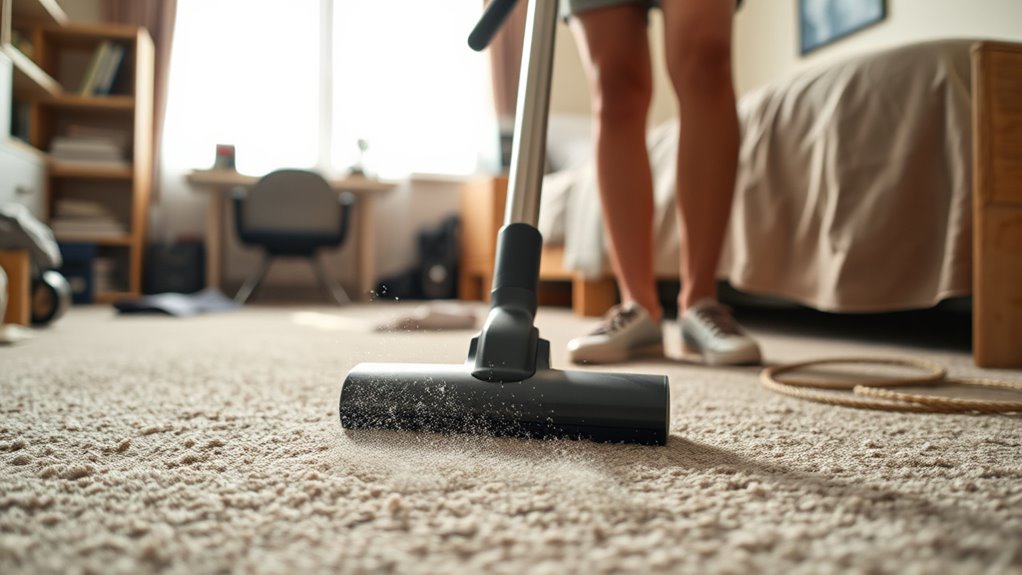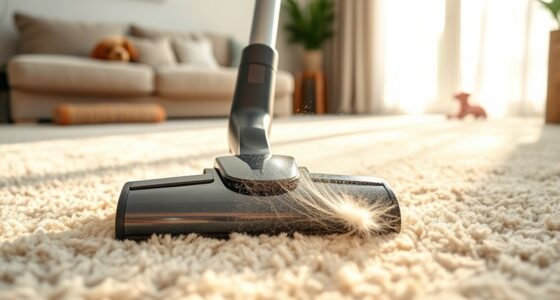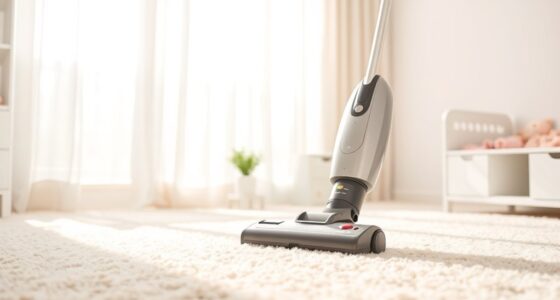To manage dust allergies in your dorm, choose a vacuum with a true HEPA filter and a long cord for efficient coverage. Vacuum at least once a week using slow, straight passes and multiple directions to loosen embedded allergens. Regularly clean or replace filters and consider using air purifiers with HEPA filters. Keep allergen-proof bedding and maintain a clean environment to reduce dust buildup further. If you keep these tips in mind, you’ll discover more ways to create a healthier dorm space.
Key Takeaways
- Use a vacuum with a true HEPA filter to trap dust mites, pollen, and pet dander effectively.
- Vacuum the entire dorm at least once a week with slow, overlapping passes for thorough dust removal.
- Empty the vacuum canister and clean filters regularly to maintain optimal suction and allergen capture.
- Incorporate air purifiers with HEPA filters to reduce airborne dust and allergens continuously.
- Wash allergen-proof bedding frequently and use protective covers to minimize dust mite exposure.
Choosing the Right Vacuum Cleaner for Dorm Allergens

When selecting a vacuum cleaner for your dorm room, it is vital to prioritize models designed to trap allergens effectively. HEPA filters are essential because they capture tiny particles like dust mites, pollen, and pet dander, preventing them from recirculating into the air. Look for vacuums equipped with true HEPA filtration to guarantee maximum allergen removal. Additionally, consider the cord length; a longer cord gives you more flexibility to clean larger areas without constantly switching outlets. This feature makes cleaning quicker and more efficient, especially in a dorm setting where outlets may be limited. By choosing a vacuum with HEPA filters and an adequate cord length, you set yourself up for a cleaner, healthier living space and reduce allergy symptoms. Using a vacuum with effective allergen removal capabilities further enhances indoor air quality and supports respiratory health.
Establishing a Weekly Vacuum Schedule

After choosing a vacuum with good allergen filtration, setting up a regular cleaning schedule helps maintain a healthy dorm environment. Aim to vacuum at least once a week to reduce dust and allergens effectively. Consistency is key to preventing buildup, so mark your schedule and stick to it. During each session, check your vacuum’s air filter for dust accumulation and replace or clean it as needed to ensure peak performance. Using allergen-proof covers on pillows and mattress protectors can also enhance your routine by trapping dust mites. Regular vacuuming combined with proper air filter maintenance minimizes allergen circulation, making your dorm a healthier space. Recognizing the importance of trust issues and maintaining a routine can prevent dust and allergen buildup from exacerbating health problems. Staying disciplined with your weekly schedule ensures dust allergies won’t take over your living environment.
Proper Vacuuming Techniques to Maximize Effectiveness

To maximize your vacuuming results, it’s important to use proper techniques that guarantee thorough cleaning without spreading dust or allergens. Focus on consistent vacuuming patterns, such as moving slowly in straight lines, then overlapping each pass. This ensures all areas are covered evenly. Use dust removal techniques like vacuuming in multiple directions to loosen embedded particles from carpets and rugs. Be sure to hold the vacuum close to the surface to improve suction and avoid pushing dust around. Regularly empty the vacuum canister or replace filters to maintain peak performance. Avoid rushing; patience allows your vacuum to pick up more dust and allergens effectively. Incorporating engine tuning techniques can further optimize your vacuum’s suction power and cleaning efficiency. By applying these patterns and dust removal techniques, you’ll considerably reduce airborne particles and improve your dorm room’s air quality.
Additional Tips for Reducing Dust and Allergens

In addition to regular vacuuming, you can further reduce dust and allergens by using high-efficiency particulate air (HEPA) filters in your vacuum cleaner. HEPA filters trap tiny particles that standard filters might miss, improving air quality and reducing allergy symptoms. Using an air purifier with similar filters offers additional benefits, continuously removing airborne allergens and dust particles from your dorm room. Also, consider investing in allergen-proof bedding, which creates a barrier against dust mites and other allergens that hide in sheets, pillowcases, and mattresses. These steps complement your vacuum routine by addressing dust both on surfaces and in the air. Additionally, selecting appropriate filtration systems can significantly enhance your efforts by targeting a broader range of airborne allergens, creating a cleaner, healthier environment, making it easier to breathe and sleep comfortably in your dorm.
Maintaining Your Vacuum and Dorm Environment

Regularly maintaining your vacuum and cleaning your dorm environment guarantees peak performance and helps keep dust and allergens at bay. Start by checking your vacuum’s filters and replacing or cleaning them as recommended, especially if you use allergen-proof covers on your bedding. Using air purifiers in your room can further reduce airborne dust and allergens, making it easier to breathe. When storing your vacuum, keep it in a dry, clean place to prevent dust buildup. Regularly wash or replace allergen-proof covers on your pillows and mattress to prevent dust mites. Cleaning surfaces with a damp cloth prevents dust from becoming airborne. Incorporating innovative materials into your cleaning routine can enhance the effectiveness of your efforts. These steps ensure your vacuum works efficiently and your dorm environment stays healthier for you.
Frequently Asked Questions
Can I Use a Handheld Vacuum for Dust Allergies in Dorms?
Using a handheld vacuum can be a great choice for tackling dorm room dust allergies. Its benefits include easy maneuverability and targeted cleaning, especially in tight spaces. You can quickly remove dust from surfaces, bedding, and carpets, reducing allergens that trigger allergies. While it’s effective for cleaning dust in your dorm, make sure to choose a model with a HEPA filter for best allergy relief. Keep up this routine for a healthier living space.
Are HEPA Filters Necessary for Effective Dust Allergy Vacuuming?
You might wonder if HEPA filters are necessary for effective dust allergy vacuuming. The answer is yes; HEPA filtration is essential because it captures tiny allergen particles, improving allergen removal. Without a HEPA filter, dust mites, pet dander, and pollen can escape back into the air, worsening allergy symptoms. Using a vacuum with HEPA filtration ensures you’re effectively reducing allergens, making your dorm room healthier and more comfortable.
How Often Should I Replace Vacuum Filters in Dorm Rooms?
You shouldn’t wait until things get messy; knowing when to replace your vacuum filter is key. Typically, a vacuum filter lifespan is around 3 to 6 months, but dorm room dust accumulation can shorten that. Regularly check your filter for dirt buildup or damage, and replace it when necessary. Staying on top of this keeps your air clean and ensures your vacuum works efficiently—don’t let dust settle in for too long.
Can Vacuuming Alone Eliminate All Dust Allergens?
Vacuuming alone may not eliminate all dust allergens, but it considerably helps with dust mite removal and allergen reduction. To improve your chances, use a vacuum with a HEPA filter and vacuum regularly, especially on carpets and bedding. Don’t forget to wipe surfaces and wash bedding frequently. Combining these steps creates a cleaner environment, reducing allergens and making it easier to breathe, especially if you have allergies.
What Are Eco-Friendly Vacuum Options Suitable for Dorm Allergies?
You might think eco-friendly vacuums can’t handle dust allergens, but sustainable cleaning proves otherwise. Biodegradable vacuums with HEPA filters effectively trap dust and allergens, making them suitable for dorm rooms. These options reduce environmental impact while maintaining air quality. Investing in a biodegradable vacuum supports your health and sustainability goals, proving that eco-conscious choices can be both effective and responsible for allergy management.
Conclusion
By sticking to your vacuum routine, you’re like a skilled gardener tending to a delicate bonsai—each careful move helps keep allergens at bay. Regular cleaning and proper techniques turn your dorm into a fresh, allergy-free oasis. Remember, consistency is your best tool, transforming what seems like a small task into a mighty shield against dust and allergens. Keep at it, and you’ll create a healthier, happier space where you can breathe easy and focus on what matters most.










